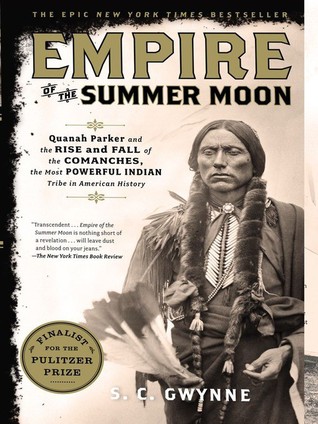More on this book
Community
Kindle Notes & Highlights
by
S.C. Gwynne
Read between
March 9 - May 8, 2023
He was new to this sort of Indian fighting, and would make many mistakes in the coming weeks. He would learn from them.
It was exactly what the Comanches did after a raid on Pawnee, Ute, or Osage villages: Pursuit was assumed, safety existed only in distance.
He would dance for hours, or days. He doted on his family, especially on his sons, and spent winters snug and indolent, wrapped in thick buffalo robes by the fire in his tipi,
Like Grant in the Civil War, Hays worried less about what his adversaries could do to him than about what damage he could inflict on them. Like Grant, too, he was all about offense. In conversation he was soft-spoken and well-mannered; in a fight he was cold as ice and firmly in command of men who quickly deferred to him.
That was all. Like Comanches, the Rangers often traveled by moonlight, navigating by river courses and the north star, and dispensing with fires altogether, making “cold camps” and eating hardtack or other uncooked rations.42 Hays’s men would sleep fully clothed and fully armed, ready to fight at a minute’s notice.
What Hays mainly understood was the value of pure audacity, of striking fear and panic in his opponents’ hearts.
Hays preferred surprise—killing them, just as the Comanches preferred to do, in their villages while they slept. He had learned the fundamental lesson of plains warfare: It was either victory or death.
He also learned quickly what would soon become his main advantage: Comanches were extremely predictable. They never changed their methods.
What Hays did appeared to be unbelievably brave to men who did not have his ability to calculate odds; he was also, it must be said, unbelievably brave.
Hays had other attributes as well; he was extremely cautious where his men’s safety was concerned, and almost motherly in his care of them when they were wounded. He was remarkably industrious in camp, hauling wood and water, staking and hobbling horses, cooking food. But “when it was a mere question of personal danger his bravery bordered closely on rashness.” He had an iron constitution that made him seemingly impervious to discomfort, bad weather, or sleep deprivation: “I have frequently seen him sitting by his campfire at night in some exposed locality,” wrote J. W. Wilbarger,
It was an astonishing display of warrior prowess. For it, Hays was promoted to major. He was not yet twenty-five.
In 1830 a sixteen-year-old with big ideas and a knack for intricate mechanics named Samuel Colt had carved his first model of a revolving pistol out of wood.
The surrender stands as a sort of bookend to the twinned fates of Custer and Mackenzie, the one destined for eternal fame and glory, the other for obscurity and oblivion.
Quanah also understood the futility of blind resistance.


